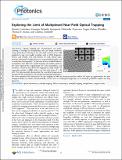Files in this item
Exploring the limit of multiplexed near-field optical trapping
Item metadata
| dc.contributor.author | Conteduca, Donato | |
| dc.contributor.author | Brunetti, Giuseppe | |
| dc.contributor.author | Pitruzzello, Giampaolo | |
| dc.contributor.author | Tragni, Francesco | |
| dc.contributor.author | Dholakia, Kishan | |
| dc.contributor.author | Krauss, Thomas F. | |
| dc.contributor.author | Ciminelli, Caterina | |
| dc.date.accessioned | 2021-07-14T14:30:27Z | |
| dc.date.available | 2021-07-14T14:30:27Z | |
| dc.date.issued | 2021-07-06 | |
| dc.identifier | 274960713 | |
| dc.identifier | d79a7d9f-8397-4bd4-aac6-79e81fb62ab6 | |
| dc.identifier | 85111028288 | |
| dc.identifier | 000677543700025 | |
| dc.identifier.citation | Conteduca , D , Brunetti , G , Pitruzzello , G , Tragni , F , Dholakia , K , Krauss , T F & Ciminelli , C 2021 , ' Exploring the limit of multiplexed near-field optical trapping ' , ACS Photonics , vol. 8 , no. 7 . https://doi.org/10.1021/acsphotonics.1c00354 | en |
| dc.identifier.issn | 2330-4022 | |
| dc.identifier.other | RIS: urn:5D9B03AC1C83131360F8075B2A1BB810 | |
| dc.identifier.uri | https://hdl.handle.net/10023/23564 | |
| dc.description | The authors G.B., F.T., and C.C acknowledge financial support by the POR of Apulia region, IT (FESR FSR 2014−2020, Action 10.4, “Research for Innovation” (REFIN) Initiative). The authors D.C., G.P., K.D., and T.F.K. acknowledge financial support by the EPSRC of the UK (Grant EP/P030017/1). | en |
| dc.description.abstract | Optical trapping has revolutionized our understanding of biology by manipulating cells and single molecules using optical forces. Moving to the near-field creates intense field gradients to trap very smaller particles, such as DNA fragments, viruses, and vesicles. The next frontier for such optical nanotweezers in biomedical applications is to trap multiple particles and to study their heterogeneity. To this end, we have studied dielectric metasurfaces that allow the parallel trapping of multiple particles. We have explored the requirements for such metasurfaces and introduce a structure that allows the trapping of a large number of nanoscale particles (>1000) with a very low total power P < 26 mW. We experimentally demonstrate the near-field enhancement provided by the metasurface and simulate its trapping performance. We have optimized the metasurface for the trapping of 100 nm diameter particles, which will open up opportunities for new biological studies on viruses and extracellular vesicles, such as studying heterogeneity, or to massively parallelize analyses for drug discovery. | |
| dc.format.extent | 7 | |
| dc.format.extent | 4546441 | |
| dc.language.iso | eng | |
| dc.relation.ispartof | ACS Photonics | en |
| dc.subject | Optical nanotweezers | en |
| dc.subject | Multiple trapping | en |
| dc.subject | Dielectric metasurface | en |
| dc.subject | Near-field trapping | en |
| dc.subject | Nanophotonics | en |
| dc.subject | Anapole modes | en |
| dc.subject | QD Chemistry | en |
| dc.subject | NDAS | en |
| dc.subject.lcc | QD | en |
| dc.title | Exploring the limit of multiplexed near-field optical trapping | en |
| dc.type | Journal article | en |
| dc.contributor.sponsor | EPSRC | en |
| dc.contributor.institution | University of St Andrews. School of Physics and Astronomy | en |
| dc.contributor.institution | University of St Andrews. Sir James Mackenzie Institute for Early Diagnosis | en |
| dc.contributor.institution | University of St Andrews. Centre for Biophotonics | en |
| dc.contributor.institution | University of St Andrews. Biomedical Sciences Research Complex | en |
| dc.identifier.doi | 10.1021/acsphotonics.1c00354 | |
| dc.description.status | Peer reviewed | en |
| dc.identifier.grantnumber | EP/P030017/1 | en |
This item appears in the following Collection(s)
Items in the St Andrews Research Repository are protected by copyright, with all rights reserved, unless otherwise indicated.

